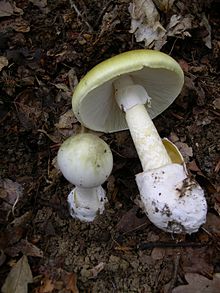
Back تسمم بعيش الغراب Arabic Envelenamientu por cogordes AST Бәшмәктәр менән ағыуланыу Bashkir Intoxicació per bolets Catalan Otrava houbami Czech Pòtrusë CSB Pilzvergiftung German Δηλητηρίαση από μανιτάρια Greek Envenenamiento por setas Spanish Mizetismo Basque
| Mushroom poisoning | |
|---|---|
| Other names | Mycetism, mycetismus |
 | |
| Amanita phalloides accounts for the majority of fatal mushroom poisonings worldwide. | |
| Specialty | Emergency medicine, toxicology |
Mushroom poisoning is poisoning resulting from the ingestion of mushrooms that contain toxic substances. Symptoms can vary from slight gastrointestinal discomfort to death in about 10 days. Mushroom toxins are secondary metabolites produced by the fungus.
Mushroom poisoning is usually the result of ingestion of wild mushrooms after misidentification of a toxic mushroom as an edible species. The most common reason for this misidentification is a close resemblance in terms of color and general morphology of the toxic mushrooms species with edible species. To prevent mushroom poisoning, mushroom gatherers familiarize themselves with the mushrooms they intend to collect, as well as with any similar-looking toxic species. The safety of eating wild mushrooms may depend on methods of preparation for cooking. Some toxins, such as amatoxins, are thermostable and mushrooms containing such toxins will not be rendered safe to eat by cooking.